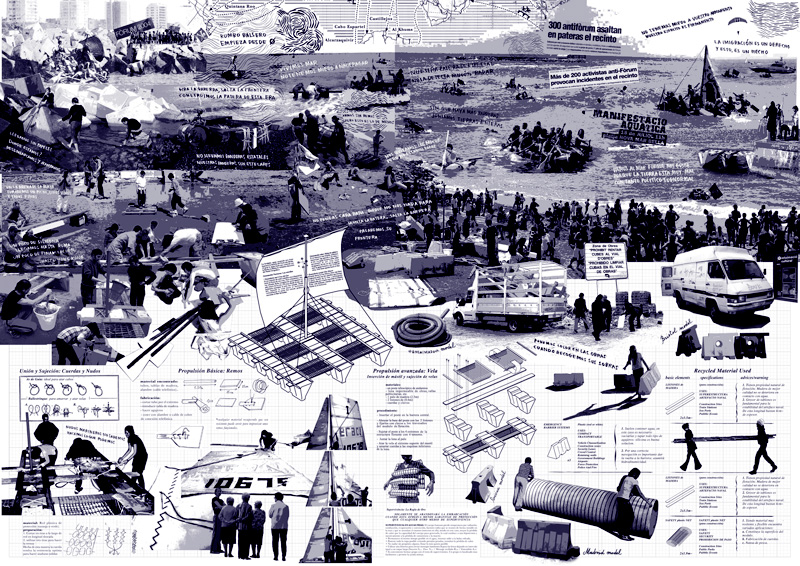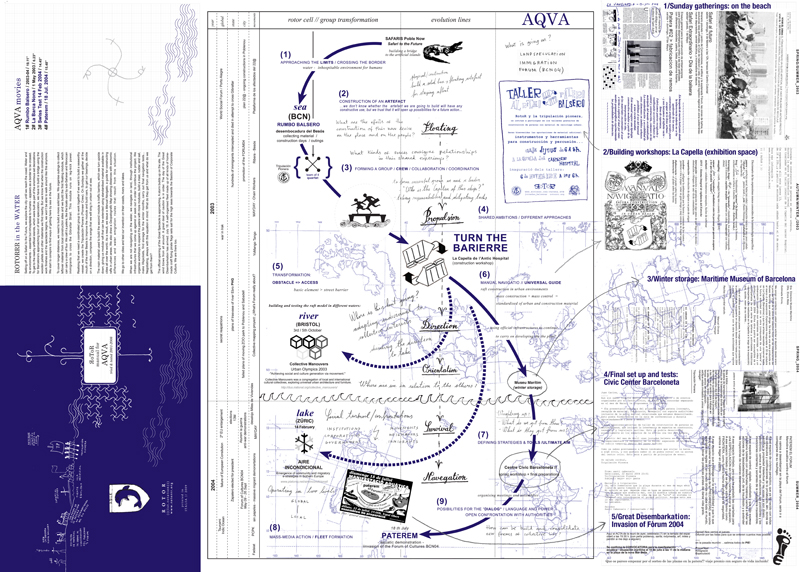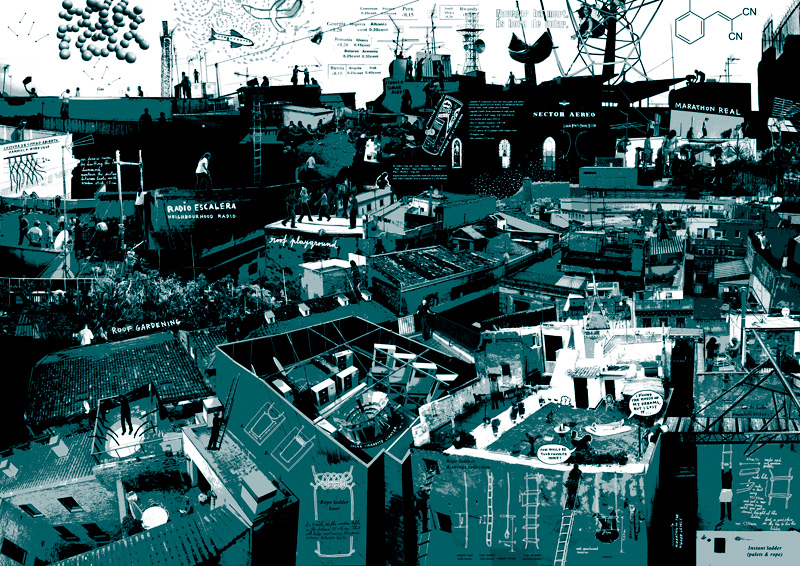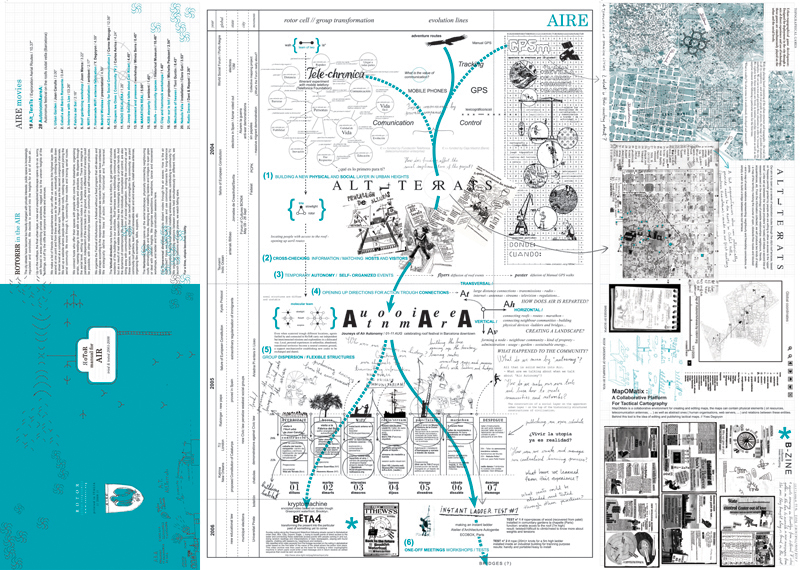for Terræ, Aqva & Air
____________________
We set out to explore our immediate surroundings – the city – in an effort to understand it and incorporate it into our vital processes. We want to form relationships with the external complexity, foreign to our bodies and our internal processes.
Territories undergoing transformation attract us because they are no longer the thing they used to be, but they haven’t yet become the next thing. Temporarily neutral spaces, battlefields in which global interests clash with local realities. These are places where we can move freely, play, name things our own way and signpost them.
As we embark on our adventure, our own bodies are the interface for exploration. Based on our own experiences, we learn about ourselves and our surroundings.
We draw temporary maps to get our bearings based on what we have learnt: places were a demolished building opens up new paths and shortcuts, obstacles that pop up in the form of new urban interventions. We locate points of access to restricted areas, mark the spots that allow us to go underground or reach different levels, where we can climb, jump, hang, crawl...
At a certain point we find ourselves in the middle of deserted lands on a Safari adventure. Bulldozers appear to us like elephants, cranes rise up like giraffes, the new shopping malls are full of ostriches running around, itinerant real estate agencies stalk their prey like panthers, new hotels stand out like luxurious colonial homes, and in the wake of demolitions gypsy colonies move from one abandoned factory to the next like nomadic indigenous tribes.
We organise thematic Safaris to explore the coast line, the leafy areas, the ruins of ancient industrial civilization. We go on a Safari to the Future and see what is going to become of all of this area. This is where the Water story begins, but that's a different chapter...
Once we are thoroughly familiar with its ins and outs, we want to understand how everything works together, as though it were a living organism. We want to know how the main systems are connected and ramify, whether they compete or mutually benefit each other. We want to find out what processes are developing in the cells that make up its tissue.
Planariae Poble Now is a simple organism in the process of mutation. Through analytic examinations, we arrive at a diagnosis and prescribe a possible cure.
We identify the place where the main artery meets the spine of the nervous system as the spot where the heart should be. But instead of a heart, we find a devastated, abandoned zone. We decide to act there, working with other groups and local residents to resuscitate it by cleaning, planting a garden, playing... by making a community park, ParcCentralPark. But this park won't turn out to be the way we imagined it...
From there
we move onto other locations, testing different ways of relating to the
territory: creating urban audio guides, compiling a new dictionary with
a manual GPS, transferring urban conflicts onto a board game....


Setting off on a Safari to the Future, we explore the city until we reach the coast. Water and its environments – essential but inhospitable to humans – appears as a border to be crossed. To get to the nearby artificial islands, which were built as part of the enormous set decorations for Barcelona's approaching bout of land speculation, we have to build a bridge using the wooden pallets and other materials we find nearby. But we know that when the construction work finishes and the spectacle begins, we won’t be able to walk around like this anymore. We start to conspire to find ways of getting here by sea in the future.
To cover longer distances, we need to build a more solid base. We organise outings to collect leftover material from local construction sites and we build the first floating module, which can carry a crew of four. We call it a patera, like the boats used by sub-Saharan and Moroccan immigrants to cross the Gibraltar Strait. This module runs on leg-kick power.
Realising that we need a coordinated group to work together if we want to build a seaworthy vessel, we create the Tripulación Pionera (Pioneer Crew). On Sundays we gather at the mouth of the river Besòs to improve the module and build oars, to get our bearings, decide on a direction, compose the songs that we will sing in unison out at sea.
The main material used to build the second module is traffic barriers, which we turn upside down, giving us modular raft that can be extended using standardised material available in cities all over the world. As a result, we issue a Manual Navigatio, a guide for constructing rafts in urban areas. We also draw a Geopatografic Map showing distances with economic differences and water emigration routes that result from this situation.
We go to other cities and test our invention on their coasts, rivers and lakes.
When we are not navigating on the water, we navigate on land, through institutional infrastructures that we come up against or seek out in order to continue the project. We organise workshops to expand the patera with more modules, build a mast, rudder and sail, make lifejackets, find storage for the winter months, carry out final navigation tests... Negotiating, always with this equation in mind: What do they get from us and what do we get from them?
The official opening of the Great Spectacle is approaching. A storm builds up on the site. The wind blows from all around. A great deal of caution is in order. The day of the Great Disembarkation has arrived: July 18. A self-organised fleet made up of all kinds of home-made craft flying pirate flags sets sail for the high seas towards the Bastion of Corporate Culture. We are there too.


The city streets have become too heavily charged with private interests: public space is increasingly regulated and controlled. We decide to ascend into the heights for a bit of fresh air...
Up on the
rooftops, the final urban layer, a new and unexplored landscape opens
up to us: sunny, with fenced in areas protecting private paradises, ragged
due to the uneven heights of the buildings, cut off by the cliffs and
canyons of streets and avenues.
We make a
list of friends and acquaintances who can offer us access to this highest
layer. We ascend at one point and from there we move as far as we can,
eventually climbing back down to street level at a completely different
spot. These routes are like secret overground channels. We set up a website
where people can register their roofs, creating new nodes and joining
the aerial community. We move through it, connecting these nodes and tracing
aerial routes.
We connect
hosts who offer their spaces with people who come from elsewhere, organising
erratic, roaming meetings to deal with a range of subjects and practices.
We disperse through the aerial level, setting up interconnected nodes
in a flexible structure. There we imagine a parallel world, independent
of the one back on the ground, where a different kind of society could
be possible, with other relationships based on community and self-management
practices.
We organise
the Festival of AirAutonomy. A festival without a fixed program that will
develop and take shape according to the responses and proposals we receive
from people we have contacted. We strategically define three lines of
action: Vertical, Horizontal and Transversal.
The Vertical
direction runs from the rooftops down: it aims to inform, to get permits
and involve residents of the buildings in our activities. Roof terraces
were traditionally communal spaces, but as a result of real estate speculation
they are increasingly ending up in private hands. And the dynamics of
contemporary life, based on the individual, consumption and control, are
also doing away with communities as a form of social organisation. Invoking
the communal use of these spaces, we organise activities that can benefit
and strengthen the community: we plant community roof gardens, learn about
renewable solar and wind energies, install wireless antennas, organising
film screenings, talks, suppers, etc.
The Horizontal
direction opens up the aerial landscape, physically connecting neighbouring
roofs: eliminating walls and fences, designing and installing ladders
and bridges to span gaps or deal with uneven heights. We organise expeditions,
marathons, dance and movement workshops, and ladder and bridge construction
sessions here.
The Transversal direction connects distant nodes through the air waves: How is the air distributed? Here we learn how to create and use communal channels for long-distance communication, making local radios, installing wireless antennas, contributing to community TV. We organise streaming sessions between events held simultaneously on different roofs, we launch hot air balloons and paper planes, we watch falling stars.
For a time, utopia becomes reality.

____________________
